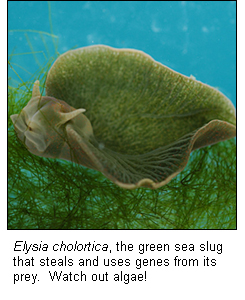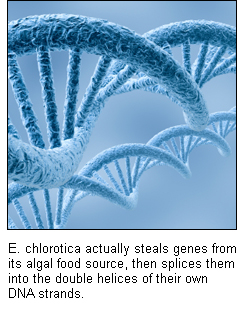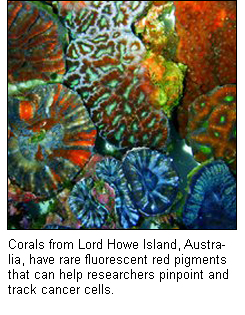Trying to See Things Differently

Things have not been going very well for the worlds ocean lately. This year has been particularly bad, at that. It started early with the Caribbean cold snap that harmed corals and turtles. They also have a pesky invasive lionfish problem. Scientific news since then has been bleak, with several reports declaring that rising water temperatures and acidity are causing massive bleaching events around the globe. The summer began with a tanker ship running aground and scarring two miles of the Great Barrier Reef. Then, in an unparalleled ecological disaster, the largest oil spill in history pumped raw crude into the Gulf of Mexico for nearly four months.
Most of us would have packed it in by now, under the same circumstances. But the ocean persists, and still offers us amazing wonders and beauties. In spite of this years troubles, or perhaps because of them, it seems necessary to look at some of the good news that comes recently from the marine realm. There could hardly be place more biologically astounding than the sea, and we would all be well-served to ponder it from time to time.

Coral Larvae Can Hear:
In May, Steven Morris reported on the findings of a Bristol University study that showed that coral larvae use some form of hearing to find their way to coral reefs. How astounding that such simple organisms, whose adult counterparts are stone deaf, could pick up sound and use it to navigate. It is really an elegant solution to a big problem. Coral spawn by releasing their gametes directly into the water column. Egg and sperm are free to mix and fertilize, but are helplessly subject to currents and waves. They could be swept virtually anywhere. Once hatched, the larvae may have only a few hours to find a good hard place upon which to settle. When you think about it, that is a tall order. Small, blind, and vulnerable, the coral larvae were previously believed to recruit only out of luck. It seems the scientists were wrong.
As it turns out, coral reef occupants live with a cacophonous din created by fish and snapping shrimp. Scuba Divers may be familiar with similar noise created by their own local species of snapping shrimp. On the reef, there are more sounds than the human ear is able to detect over the noise of a regulator. However, fish larvae, and evidently those of coral, are able to hear the noise and migrate toward them. The researchers used a simple, two-option test on coral larvaesettle in a noisy or a quiet place. Amazingly, the overwhelming preference was for the area where a recording of an actual reef was being played back. The coral larvae thus heard, and chose to follow, the sound of the reef.
Unfortunately, it appears there is one rotten egg in this otherwise good dozen. Human noises can mask those of the reef, thereby confusing coral larvae. Instead of migrating toward good habitat, they are drawn to piers, boats, and other anthropogenic sources of sound. This interference may prove detrimental to coral recruitment on reefs. I prefer, instead, to reflect upon just how astounding is this discovery. The coral larvae can hear! It may not be hearing like people have, but it is hearing nonetheless. They are very anatomically simple, yet somehow have evolved this profound ability. Bravo, coral larvae, bravo!

The Slug That Became a Plant:
Well, not literallybut pretty close. Though the study was first reviewed in 2008, news about it lagged a bit. There is a sea slug, called the walking leaf slug (Elysia chlorotica), that can express horizontally transferred genes. In short, the slug steals genes from the algae that it eats. It then uses the genes to maintain chloroplasts it has also absorbed. Pretty amazing, huh? It gets better.
This sort of horizontal gene transfer is unheard of. Viruses and bacteria have the ability to transfer genes, and we even have the remnants of some in our very own DNA. Yet, this is different. What we have in our genes is the result of vertical transfer. That is, when the foreign DNA was inserted originally (perhaps millions, or even billions, of years ago), it became a permanent part of our genome. It was passed on to every subsequent generation in our family tree before finally reaching usbasically a self-perpetuating happenstance. It was also transferred from a prokaryotic cell (no nucleus) to a eukaryotic cell (with a nucleas). In the case of the sea slug, the genes must be regained by each new individual, and the transfer is from eukaryote to eukaryote. In other words, the juvenile slug does not inherit the genes from its parentsit must eat them. And the genes it gets are far more complex than anything that could come from a bacterium.
What is more fascinating is that slug incorporates the DNA into its own, then uses it the same way the algal cell did. Even more astonishing is the fact that the DNA is not even that of the algae. Instead, it is the DNA of the chloroplast itself. Chloroplasts are called plastids, and they originally evolved as their own unique organisms. Archaic chloroplasts housed their own DNA inside that of their host cell until the two cells eventually merged into a single organism. However, the chloroplast DNA persisted through eons. Though they are no longer their own organisms, 90% of the chloroplast genome is expressed in the plant or algal cell that contains. When E. chlorotica consumes an algal cell, it sorts out the chloroplasts and DNA bits it needs. The chloroplasts are then absorbed whole through the lining of the gut, while the DNA is somehow assimilated into the slugs own genome. Through this mechanism, the slug is able to keep chloroplasts alive much longer than would be possible in the absence of the genes. The result is slug that gets fat off of sunlight. It actually photosynthesizes! Plus, they look just like green leavesdown to the veins and everything. The chloroplasts eventually permeate the entire body, giving this slug an unusually verdant appearance.

Lord Howe Island Corals Can Give us a Glimpse Into Cancer Cells:
For millennia, people have used the natural chemicals produced by living animals to their advantage. This is as true today as it ever was, and perhaps even more so. If you are familiar with marine biology or ecology, you probably know that pharmaceutical companies have pursued interests in the oceans animals for decades. Since so little of the marine realm has been explored, and even less understood, one can assume that there are thousands of beneficial chemicals out there just waiting to be discovered. Funny enough though, I did not think it would be this. Fluorescent compounds derived from the tissues of corals are being used to compare cancerous and non-cancerous cells.
Evidently, the fluorescence can help doctors and medical scientist better see growth and changes in cells. Using a specially-designed laser microscope, it is possible to actually see certain cells glowing. The implications of such technology is profound because it can provide a look into the previously unviewable reaches of living cells and tissues.
Unfortunately, not all pigments work the same. Blue, yellow, and green all serve some purpose, but red is the real deal-breaker. Red fluorescent pigments are capable of providing the deepest views of tissues. Therein lies the rubred is a relatively rare fluorescent pigments, and is difficult to find in the wild. Researchers studying coral bleaching off of Lord Howe Island, Australia, happened upon a previously unknown stretch of reef that contains hundreds of strongly fluorescent corals. Many of the animals possess the strongly-desired red pigments.
This little coral oasis was a big find. Not only does it hold the potential to advance cancer studies for many years to come, it will also be to measure global climate change. Hurray for red fluorescent pigments!
Taking it All in:
Coral larvae that can hear, a sea slug that steals genes, and a cnidarian pigment that may help doctors better understand cancer. If bad news can come in threes, so too can good news. This trio of exciting discoveries is inspiring. They stand as a reminder of the rich rewards a healthy ocean can offer. We will never unlock all its mysteries (I hope), and yet every new discovery brings us closer to knowing it.
Works Cited:
Khan, A. Study Links Coral Growth to Sound. Los Angeles Times. May 20, 2010. URL: < http://articles.latimes.com/2010/may/20/science/la-sci-coral-20100516 >
Milius, S. Green Sea Slug is Part Animal, Part Plant. Science News. 2010. URL: < http://www.wired.com/wiredscience/2010/01/green-sea-slug/ >
Rumpho, M.E., et al. Horizontal Gene Transfer of the Algal Nuclear Gene psbO to the Photosynthetic Sea Slug Elysia Chlorotica. Proceedings of the National Academy of Sciences, USA, 105: 46. pp. 17867-17871. 2008.
Staff. Lord Howe Corals Light up Cancer Fight. ABC Science. 2010. URL: < http://www.abc.net.au/science/articles/2010/08/16/2984168.htm >
Vermeij, M.J.A., et al. Coral Larvae Move Toward Reef Sounds. Public Library of Science One, 5:5. 2010.